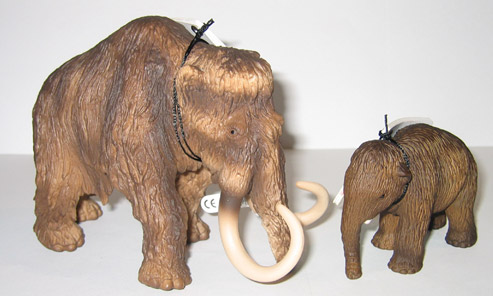A Maternal Mammoth
Did Woolly Mammoths make Good Mothers?
With the many fossils of Woolly Mammoths (Mammuthus primigenius) and the ancestral type Mammuthus meridionalis, plus the opportunity to observe modern elephant species, scientists have built up a detailed picture of the lives of Woolly Mammoths. Well preserved frozen carcases from Siberia and other remarkable finds have enabled researchers to piece together a picture of what it must have been like to be a Mammoth in the Pleistocene, wandering the extensive, grassy plains of northern Europe.
Daniel Fisher of the Michigan University has pioneered a method of determining the age of Mammoths at death by analysing cross sections of the tusk. It seems that Mammoths could live to about the age of sixty, a lifespan slightly shorter than the African and Asian elephants. Like modern elephant species they lived in a sophisticated, highly structured social hierarchy. The females and young animals lived in herds together, with perhaps a matriarch figure, the oldest female in the group acting as leader. Mature bulls lived a solitary existence, coming into contact with females only to mate. Younger males may have formed small herds, gathering together for protection from predators such as Dire wolves and Sabre-tooth cats.
Maternal Mammoths
Competition for mates was probably a common site when the females came into season. One Mammoth fossil found in Nebraska comprises two skulls locked together by their curling tusks, the combatants, probably males must have become entangled during a fight and then unable to separate themselves. They must have died a slow and lingering death from starvation.
As with most mammal species adapted to northern climates, mating probably occurred in the Summer months. With a twenty-two month gestation period, a female Mammoth that conceived in July would give birth in the next May but one, allowing the calves to have a few months of warm, mild weather before the winter and any migration that was undertaken. Having a calf in the spring would also benefit the Mammoth mothers as they would have plenty of new grazing to help them produce the milk required for their offspring. A single calf would be born, and this calf would probably depend on it’s mother’s milk for at least two years. The calf being dependent on the mother coupled with the long gestation period would have meant that mature females would only have been able to breed once every four years.
A Mother and Calf Woolly Mammoth

Picture credit: Everything Dinosaur
The Mammoths in the picture are models from the Schleich Prehistoric Mammals series. These are 1:20 scale models of Pleistocene age mammals which are now extinct. In recognition of the maternal instincts of Mammoths, the Everything Dinosaur team supply the adult Mammoth model and the baby as a set.
To view models of prehistoric mammals: Models of Prehistoric Mammals.
Many large mammals produce just a single calf and dedicate a lot of resources into nurturing their offspring. This strategy is effective so long as the adult population does not decline. As has been seen with African elephants, if there is much predation of adult animals, as with poaching for example, then the population can crash dramatically.
Some researchers have claimed that Mammoths would look after each other and orphaned calves would be fostered. There is also some fossil evidence to suggest that Mammoths like modern elephants were reluctant to abandon a dead or dying member of their group. Offspring off both sexes probably stayed in the female herd until about 10-12 years of age, before the males moved on to form bachelor groups.

